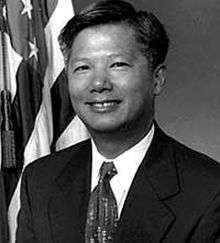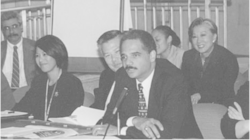Bill Lann Lee
| Bill Lann Lee | |
|---|---|
 1997 Portrait | |
| Assistant United States Attorney General for the Civil Rights Division | |
|
In office 1997 – January 20, 2001 | |
| Preceded by | Deval Patrick |
| Succeeded by | Ralph F. Boyd, Jr. |
| Personal details | |
| Born |
February 5, 1949 New York City |
| Political party | Democrat |
| Spouse(s) | Carolyn Yee |
| Children | Mark, Nicholas and Angela |
| Residence | Berkeley, California |
| Occupation | Attorney |
| Website | |
Bill Lann Lee (born February 5, 1949) is a Chinese American civil rights lawyer who served as Assistant United States Attorney General for the Civil Rights Division for the United States Department of Justice Civil Rights Division under President Bill Clinton.[1]
He is married to Carolyn Yee with whom he has two sons and a daughter. He currently resides in Berkeley, California.
Early life and education
Born February 5, 1949 in New York City, Lee and his family were not strangers to discrimination and bigotry. Lee's father had endured racial taunting as a young man. He hoped for better treatment after he returned from serving honorably in World War II, where he felt he was treated as an equal. However, when he returned to New York, he was denied housing and employment due to his race.[2]
Lee's parents owned a small hand laundry, where they made a modest living and taught Lee and his brother Ernest valuable life lessons about family, hard work, justice, and patriotism.[2]
After graduating from the Bronx High School of Science, Lee attended Yale University on a scholarship. As an undergraduate, Lee majored in History and was elected to Phi Beta Kappa. He graduated magna cum laude in 1971. Throughout school, both as a young child and a student at Yale, Lee felt alienated from the greater society because of his Asian heritage. In 1974, he earned his J.D. from Columbia University Law School, where he was a Stone Scholar and won the Best Moot Court Prize.[2]
Civil rights career

While a law student, Lee worked as a research assistant for Jack Greenberg, Thurgood Marshall's successor at the NAACP Legal Defense and Educational Fund (LDF). After graduating from law school, he returned to the Legal Defense Fund and worked there as a civil rights attorney until 1982. While still affiliated with LDF, from 1979 - 1980, Lee served as Counsel for the Asian American Legal Defense and Education Fund. He then moved to Los Angeles in 1983, where he was Supervising Attorney for Civil Rights Litigation at the Center for Law in the Public Interest until 1988. He then returned to the Legal Defense Fund to serve as the director of its Western Regional Office.[2]
In 1997, President Bill Clinton nominated Lee to the nation's highest civil rights post - Assistant Attorney General for Civil Rights in the U.S. Department of Justice. His nomination, like Lani Guinier's before him, faced significant opposition from conservatives concerned with his views on affirmative action. He stayed in the position as acting Assistant Attorney General for two-and-a-half-years before being recess appointed by President Clinton in 2000. He was never confirmed to this position by the Senate.[3] Lee became the highest-ranking Asian-American in the Department of Justice, where he led successful efforts to strengthen the nation's hate crime laws, improve access and opportunities for Americans with disabilities, fight against housing discrimination, and spearheaded efforts to toughen laws against human trafficking and involuntary servitude.[2]
Serving until the end of the Clinton White House despite the Senate's refusal to confirm him, Lee returned to his alma mater, Columbia University Law School, as a visiting scholar, and wrote a report on international human rights for the Ford Foundation.[2]
In November 2001, Lee accepted a position as a partner with the law firm of Lieff Cabraser Heimann and Bernstein, where he directed the firm's human rights practice and co-chaired the employment practice.[2] In 2006, Lee left Lieff Cabraser to become a name partner at Lewis Feinberg Lee Renaker & Jackson in Oakland, Ca.<ref =LewisFeinberg>"Archived copy". Archived from the original on 2008-07-04. Retrieved 2008-04-17. Bill Lann Lee Profile, Lewis Feinberg Lee Renaker & Jackson website, last accessed April 17, 2008</ref>
Continuing his civil rights work, Lee chaired the bipartisan National Commission on the Voting Rights Act, which compiled evidence for the successful extension of the Act in July 2006. He also chaired the Bar Association of San Francisco’s Task Force that produced a report on diversity in San Francisco law firms.<ref =LewisFeinberg>"Archived copy". Archived from the original on 2008-07-04. Retrieved 2008-04-17. Bill Lann Lee Profile, Lewis Feinberg Lee Renaker & Jackson website, last accessed April 17, 2008</ref> He is a board member of Advancement Project.
Honors
Lee has written briefs in many U.S. Supreme Court cases and has presented oral arguments before seven U.S. Circuit Courts of Appeal. He has been an active member of several professional organizations, including the Los Angeles County Bar, the Ninth Circuit Judicial Conference, the Southern California Chinese Lawyer Association, and the American Bar Association.[2]
He has received many honors for his outstanding career in civil rights law, including the Thurgood Marshall Medal of Justice (1998), the Trailblazer Award from the National Asian Pacific American Bar Association (1999), and the John Randolph Distinguished Service Award, U. S. Department of Justice (2001). He has also been awarded honorary doctorates in law from City University of New York Law School (2001), North Carolina Central University (2000), and Wesleyan University (1999).[2]